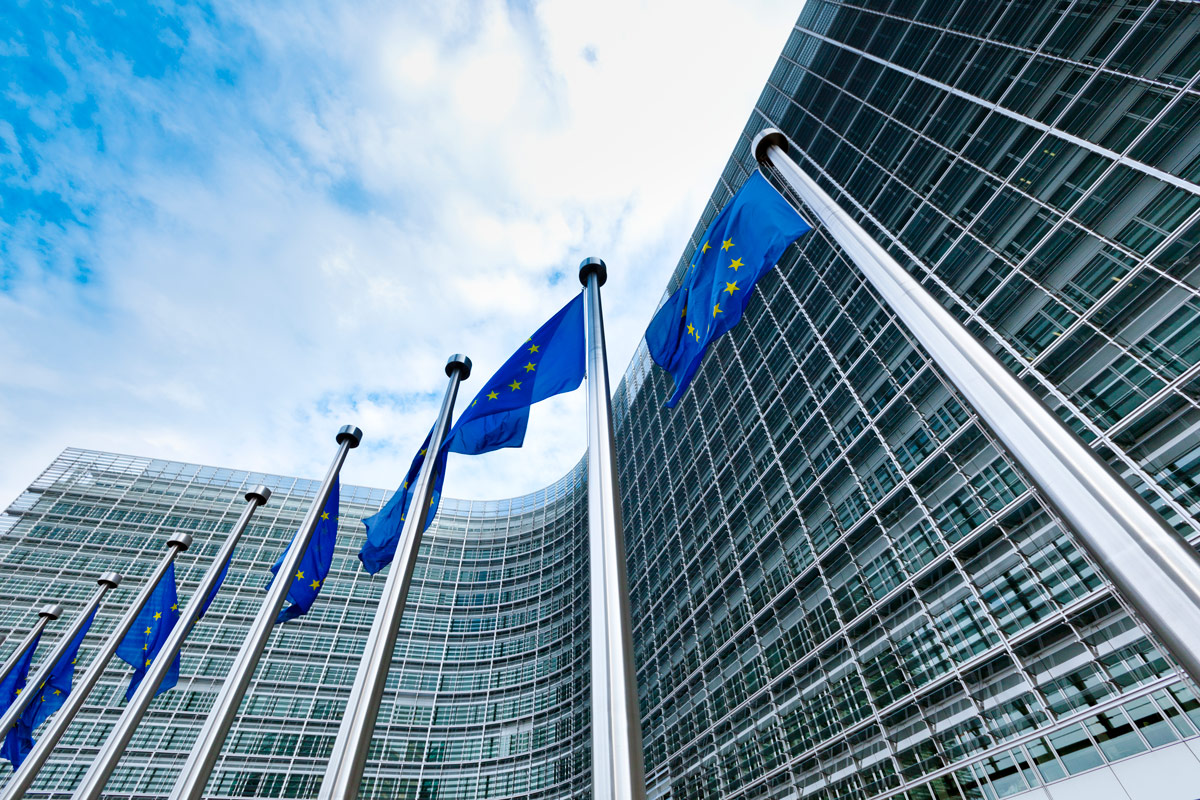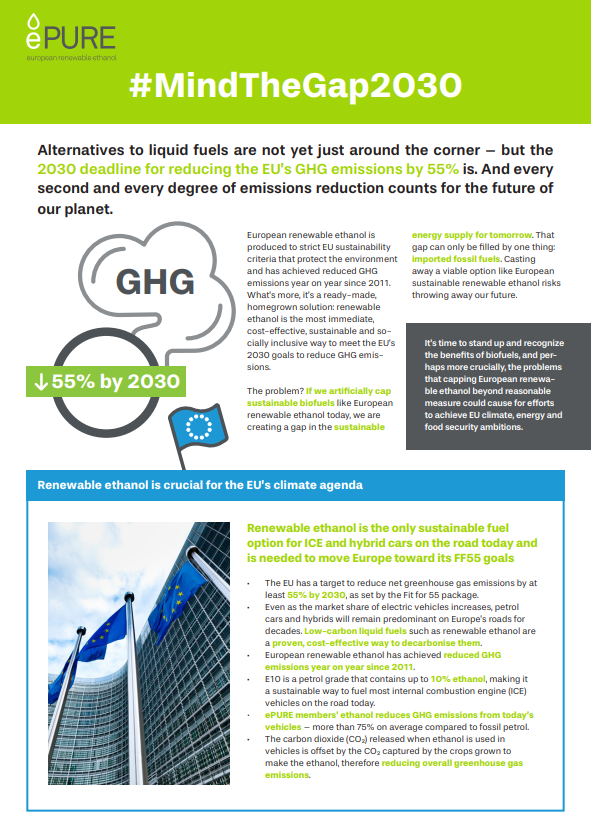Can bioethanol help the EU meet its 2030 Goals?
Alternatives to liquid fuels are not yet just around the corner – but the 2030 deadline for reducing the EU’s GHG emissions by 55% is. And every second and every degree of emissions reduction counts for the future of our planet.
European renewable ethanol (also known as bioethanol) is produced to strict EU sustainability criteria that protect the environment and has achieved reduced GHG emissions year on year since 2011. What’s more, it’s ready-made, homegrown solution: renewable ethanol is the most immediate, cost-effective, sustainable and socially inclusive way to meet the EU’s 2030 goals to reduce GHG emissions.
Can bioethanol help the EU meet its 2030 Goals?
Alternatives to liquid fuels are not yet just around the corner – but the 2030 deadline for reducing the EU’s GHG emissions by 55% is. And every second and every degree of emissions reduction counts for the future of our planet.
European renewable ethanol (also known as bioethanol) is produced to strict EU sustainability criteria that protect the environment and has achieved reduced GHG emissions year on year since 2011. What’s more, it’s ready-made, homegrown solution: renewable ethanol is the most immediate, cost-effective, sustainable and socially inclusive way to meet the EU’s 2030 goals to reduce GHG emissions.
Adjust the cap for renewable ethanol
If we artificially cap sustainable biofuels like European bioethanol today, we are creating a gap in the sustainable energy supply for tomorrow. That gap can only be filled by one thing: imported fossil fuels. Casting away a viable option like European sustainable renewable ethanol risks throwing away our future.
It’s time to stand up and recognize the benefits of biofuels, and perhaps more crucially, the problems that capping European bioethanol beyond reasonable measure could cause for efforts to achieve EU climate, energy and food security ambitions.
Here’s why the EU needs renewable ethanol to move beyond imported fossil fuel
Maintaining the EU cap on sustainable #biofuels will create a gap that will be filled by fossil fuels. We believe renewable ethanol can and should can be part of the solution. Watch our video explainer.
#MindTheGap2030
#MindTheGap2030
What is European renewable ethanol?
Renewable ethanol is a biofuel produced sustainably from European crops and agricultural wastes and residues. E10 is a petrol grade that contains up to 10% ethanol, making it a sustainable way to fuel most internal combustion engine (ICE) vehicles on the road today, significantly lowering transport greenhouse gas emissions.
How can European bioethanol help reduce greenhouse gas emissions?
Biorefineries process European agricultural feedstock (crops, wastes, residues) into sustainable, renewable fuel. With crop-based ethanol, for each tonne of fuel produced there is also a tonne of high-protein, GMO-free animal feed. The carbon dioxide (CO2) released when ethanol is used in vehicles is offset by the CO2 captured by the crops grown to make the ethanol, therefore reducing overall greenhouse gas emissions. In this way, the refineries are part of a circular economy that makes the most effective use of land and waste materials and reduces reliance on fossil fuel. What’s more, because bioethanol is produced domestically, it also contributes to ensuring secure and affordable energy for Europeans.
Learn more about renewable ethanol, how it’s produced, and the benefits it brings.
What can we do to protect the availability of European renewable ethanol?
- Share our fact sheet with someone you know
- Post your support on social media:
Time for a reality check: adjusting the cap for renewable ethanol in the #EU can reduce #ghg emissions, boost rural economies, support Europe’s drive to a circular economy and provide secure and affordable energy. #MindTheGap2030 - Follow us on social media:
Frequently Asked Questions (FAQ)
What is European renewable ethanol?
European renewable ethanol (or bioethanol) is a biofuel produced sustainably from European crops and agricultural wastes and residues. Renewable ethanol is manufactured in biorefineries by fermenting sugars which either come from agricultural crops or from agricultural waste and residue material.
What is European renewable ethanol used for?
The EU ethanol market can be broadly split into three segments: fuel, potable and industrial.
Fuel: In fuel, ethanol is used as an additive in petrol, seen as E5, E10, at the pump; or as an alternative fuel (E85, ED95). E10 is a petrol grade that contains up to 10% ethanol, making it a sustainable way to fuel most internal combustion engine (ICE) and hybrid vehicles on the road today, significantly lowering transport greenhouse gas emissions.
Potable: Ethanol can also be used to produce spirit drinks, such as vodka or gin, as a food additive, for the extraction of aromas, for food preservation and the production of white vinegar.
Industrial: Ethanol is also used as a renewable chemical component in various products (e.g. sanitizing products, cosmetics, pharmaceuticals, solvents, paints and de-icing fluids), as well as a renewable raw material for bio-based chemical production (e.g. bio-ethylene).
How is European renewable ethanol made?
Renewable ethanol is manufactured in biorefineries by fermenting sugars into alcohol. In the EU, these sugars typically come from a variety of agricultural sources such as wheat, corn, barley, rye, triticale, and sugar beet. While the feedstock used varies depending on market conditions, the majority of renewable ethanol biorefineries are built to specifically process either grains or sugar beets. Currently, the most commonly used feedstocks in Europe are corn, sugar beet and wheat.
However, renewable ethanol also optimises resource efficiency by using agricultural waste and residue material. This is known as advanced ethanol. The complex production process for ethanol made from cellulosic material, waste or residues requires breaking down the feedstock into fermentable sugars. To achieve this, innovative technologies in the form of enzymatic hydrolysis and pre-treatment are used. Once this process is completed, the remaining production steps are similar to those used to make ethanol from agricultural crops.
Is European bioethanol sustainably sourced?
European bioethanol is produced to strict EU standards – including the sustainability criteria set in the Renewable Energy Directive – that protect the environment. It is a sustainably produced substance, optimising resource efficiency by using mostly agricultural waste and residue material. In 2018 the EU agricultural area used to cultivate crops for European ethanol and its co-products was just 2.2% of EU utilised arable area. This makes EU ethanol near-zero risk of indirect land use change (ILUC).
What are the climate benefits of European renewable ethanol?
Is European renewable ethanol bad for the environment?
Can European bioethanol help reduce our dependence on imported fossil fuels?
Because bioethanol is produced domestically, it contributes to ensuring secure and affordable energy for Europeans. In the absence of bioethanol, motorists currently using E10 grade petrol would have to use 100% fossil fuel to fuel their cars instead, which would require having to import higher levels of crude oil from outside the EU.
Will using European renewable ethanol damage my car?
E10 is a petrol grade that contains up to 10% ethanol, which makes it a sustainable alternative to crude oil. E10 can be used by the majority of internal combustion engine (ICE) and hybrid vehicles on the road today. For more information, visit e10info.eu
Is it not better to switch to an electric car?
Although there have been great advancements in technology over recent years, we are still a long way off from being able to rely solely on electric cars. According to the European Commission, by 2030 battery-electric vehicles will account for only about 14% of the EU car fleet, with plug-in hybrid electric vehicles making up 6% and other internal combustion engines (including hybrids) at 80%. Given this, if Europe is to decarbonize the transport sector by 2030 it will need an alternative solution. That is why, using E10 fuel (a petrol grade using up to 10% ethanol) is a sustainable option that can be lower greenhouse gas emissions.
Why is European bioethanol being capped by the European Commission?
In the 2018 Renewable Energy Directive (RED II) the European institutions decided to cap crop-based biofuels (including ethanol) to a maximum of 7% in each member state. The reasons for this were to address sustainability concerns regarding biofuels with ILUC potential. However, these concerns have now largely been addressed. In 2018 the EU agricultural area used to cultivate crops for European ethanol and its co-products was just 2.2% of EU utilised arable area. This makes EU renewable ethanol low-ILUC.
How would amending the cap on renewable ethanol in RED III help the EU reach its 2030 climate goals?
By amending the cap to 7% at EU level (instead of separate caps in each individual member state) those Member States that produce a large amount of renewable ethanol could reach their full potential, while other Member States with a lower production of renewable ethanol could focus their activities elsewhere. This would reduce the need for imported energy, while keeping the overall percentage of biofuel the same across the EU.



